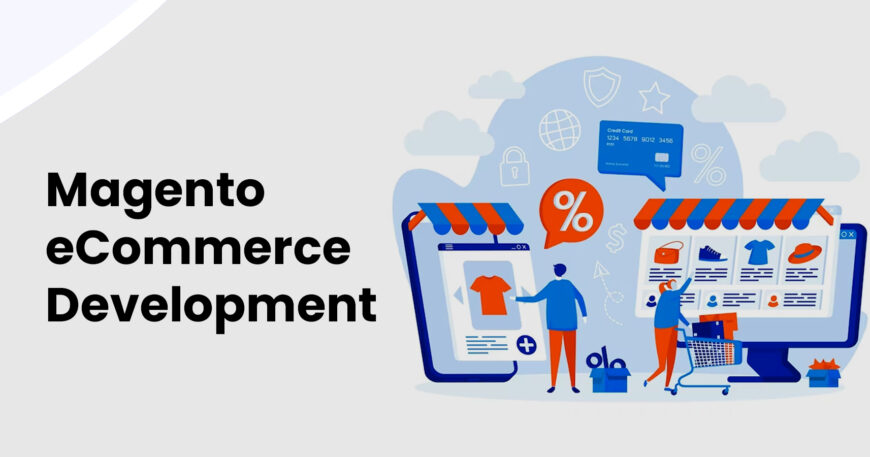The Magento eCommerce development software provides solid features for online businesses and extensive functional customization. The foundation of the eCommerce platform, Magento, is an open-source technology. Magento’s open-source software allows you or a developer to modify and adapt the program to your needs if you ever find that it doesn’t fit your requirements. The online product and service sales capabilities include catalog management, content editing, search engine optimization, and more.
Strengths of Magneto
1. Scalability
Scalability is one of Magento’s strongest strengths. Without changing the Magento eCommerce development software, it can support a range of business sizes, from small operations to enterprises. Magento can support all these enterprises, whether they have a website with tens or hundreds and thousands of visitors, a small selection of products, or a large inventory.
2. Flexibility
The flexibility of Magento extends to its capacity for managing inventories, stock control, and catalogs. Users can add, change, or remove text, photos, layouts, landing pages, and categories from the content on their websites. This Magento eCommerce development platform offers the essential components, including metadata, microdata, and alt text, to increase visibility on search engines by assisting search engine optimization.
Is Magento a Popular Choice?
Magento enjoys a high level of popularity in the eCommerce space. According to Alexa, the Magento eCommerce development platform is ranked first out of 100,000 websites, closely followed by the WordPress add-on WooCommerce. There are many aspects to mull over when deciding whether Magento is the best option for a company.
They are:
- Time: The readiness to dedicate time to mastering a new platform.
- Scale: The demand for software that can expand with a company’s growth without requiring modifications in the future.
- Traffic: Stability to manage heavy website traffic.
- Integration: Possibility of interface with different software programs, such as shipping systems.
- Security: A significant emphasis on security and PCI compliance, as well as reliance on the Magento community for help and knowledge-sharing.
If these factors align with a user’s requirements and preferences, the Magento eCommerce development platform will likely suit their eCommerce needs.
Front-end: User-Friendly Experiences
The front end of a Magento eCommerce development website is what customers see. The header at the top, the content area in the middle, and the footer are the three primary elements clients will see when they access the website’s front end.
1. Header
The header often includes links, a greeting, the corporate logo, links to the account and shopping cart, search capabilities, and links to other web pages like landing pages or category sites.
2. Footer
Typically, the footer contains widgets like newsletter signup forms, external links, and information like “About Us” and “Contact Us.” There may be a widget for product-related tags toward the bottom of the page.
3. Middle Area
Anything in between these areas is represented by the content for various pages. For instance, the home page might have a slideshow at the top, three sections with calls to action, and a list of new products. You can view and filter additional product photographs and add more details about the item via a description, a list of the product’s qualities, and user reviews.
Category
When you go to a specific category, the header and footer are still present when but the material in between is changed. You may view information like the name, price, and stock level when you click on a product inside a category. Customers can select choices like size and color before adding the item to their shopping basket.
Standard Elements
There may also be standard elements on eCommerce websites, such as wish lists, product comparisons, and sharing opportunities. Customers may also see related goods on display and add similar goods to their shopping carts.
Customers can just add the items they want to their cart and check out to complete the transaction.
Back End: Overview of Your Operations
The back end, also called the admin area, gives a thorough insight into the business operations.
Operations
When you log in to the Magento eCommerce development website, you have access to a thorough overview of your operations by switching to the back end or admin section. You can control several features of your online store in this area, including product inventories, order processing, customer information, and website settings. Magento’s eCommerce development platform offers features for adding and modifying products, selecting shipping choices, maintaining customer accounts, implementing discounts and promotions, and more.
Sales
You’ll see a summary of your sales data when you first log in to the Magento back end. Managing sales orders is one of the main aspects of the Magento eCommerce development platform.
Orders
You can examine a list of orders in this section, along with information like the billing name, shipping name, and address. The state of each order—whether it is finished, awaiting payment, or ready for picking—is used to categorize it. Order administration is made simple, with easy access to previous orders, even those from many years ago.
Product Management
The Magento eCommerce development platform allows you to submit numerous photos, enter metadata for search engine optimization (SEO), and allocate prices here. Adding characteristics to products is a fantastic feature of Magento. When utilizing filters, it’s essential to avoid attributes with ambiguous values that can mislead customers.
Product Categories
Magento eCommerce development platform allows you to manage product categories at the back end. It allows adding, modifying, and eliminating categories. You can choose which products should appear under each category.
Content Management System (CMS)
You can monitor customers, make promotions, manage mailings, and change pages. For instance, you can quickly make changes in the CMS pages area if you wish to edit the “Contact Us” page.
Reporting
Magento offers various reporting options, including sales data, to help you assess your company’s health. These reports provide information on customer behavior, sales trends, and other essential variables.
Personalizing Your Website
Additionally, you have the freedom to set and personalize the look of your website during Magento eCommerce development. You can ensure that it matches your brand and the user experience you want to give your consumer.
Conclusion
Magneto is an eCommerce platform that uses open-source code. Because it is open-source, you can alter the program and tailor it to meet specific corporate requirements. Its main advantages are flexibility and scalability. Customers may navigate various sections, examine products, make decisions, and finish purchases using Magento’s sophisticated front-end experience.
With the backend of Magento’s eCommerce development platform, you have complete control over your eCommerce operations. It enables you to manage products, orders, customers, promotions, and content more effectively. You can manage and personalize your online store with the help of this extensive feature set.
If you require assistance with Magento’s eCommerce development, the skilled professionals at Vserve are ready to provide their expertise.
The video ‘Magento 1 Beginner Tutorials – 01 What is Magento?’ by ‘Digital Startup’ inspired this blog.





